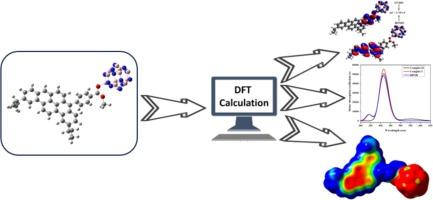Structural modulation of methyl 4-(2,11-diisopropylbenzopentaphen-5-yl based chromophore with B12N12 nano cage for enhancing the NLO Properties: A DFT study
IF 3
3区 化学
Q3 CHEMISTRY, PHYSICAL
引用次数: 0
Abstract
Currently, key electronic and nonlinear optics (NLO) properties of DPOB chromophore were explored through doping with B12N12 nanocage. Therefore, two complexes I and II were designed by doping nanocage on methoxy and carbonyl group of DPOB at minimum distance. The DFT/TD-DFT approaches at B3LYP-GD3/6-311G(d,p) functional were utilized to accomplished the NLO properties. A band gap: 3.109 and 2.707 eV in complexes I and II, respectively with higher value of softness and least hardness were investigated in doped material than their pure forms (DPOB and B12N12). The hyperpolarizability of studied compounds increases as: B12N12 < DPOB<Complex I<Complex II. Among all investigated compounds, complex II showed the maximum values of dipole moment (15.826 D), linear polarizability (7.04 × 102 a.u.) and non-linear polarizability (βtot = 4.13 × 103 and γtot = 6.70 × 105a.u.). These findings illustrated that doping of inorganic nanocages over organic surfaces is an efficient strategy to improve the NLO properties.

用 B12N12 纳米笼对 4-(2,11-二异丙基苯并五苯-5-基)甲基发色团进行结构调整以增强 NLO 性能:DFT 研究
目前,通过掺杂 B12N12 纳米载体探索了 DPOB 发色团的关键电子和非线性光学(NLO)特性。因此,通过在 DPOB 的甲氧基和羰基上以最小距离掺杂纳米载体,设计了两种配合物 I 和 II。利用 B3LYP-GD3/6-311G(d,p) 功能的 DFT/TD-DFT 方法来实现 NLO 性能。带隙与它们的纯形式(DPOB 和 B12N12)相比,掺杂材料中的配合物 I 和 II 的带隙分别为 3.109 和 2.707 eV,软度值更高,硬度最低。所研究化合物的超极化率随着以下因素的增加而增加:B12N12 < DPOB< 复合物 I< 复合物 II。在所有研究化合物中,复合物 II 的偶极矩(15.826 D)、线性极化率(7.04 × 102 a.u.)和非线性极化率(βtot = 4.13 × 103 和 γtot = 6.70 × 105a.u.)值最大。这些发现表明,在有机物表面掺杂无机纳米笼是改善 NLO 特性的有效策略。
本文章由计算机程序翻译,如有差异,请以英文原文为准。
求助全文
约1分钟内获得全文
求助全文
来源期刊

Computational and Theoretical Chemistry
CHEMISTRY, PHYSICAL-
CiteScore
4.20
自引率
10.70%
发文量
331
审稿时长
31 days
期刊介绍:
Computational and Theoretical Chemistry publishes high quality, original reports of significance in computational and theoretical chemistry including those that deal with problems of structure, properties, energetics, weak interactions, reaction mechanisms, catalysis, and reaction rates involving atoms, molecules, clusters, surfaces, and bulk matter.
 求助内容:
求助内容: 应助结果提醒方式:
应助结果提醒方式:


